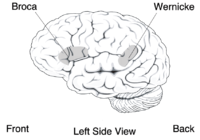
Photo from wikipedia
Purpose This study examined discourse characteristics of individuals with aphasia who scored at or above the 93.8 cutoff on the Aphasia Quotient subtests of the Western Aphasia Battery-Revised (WAB-R; Kertesz,… Click to show full abstract
Purpose This study examined discourse characteristics of individuals with aphasia who scored at or above the 93.8 cutoff on the Aphasia Quotient subtests of the Western Aphasia Battery-Revised (WAB-R; Kertesz, 2007). They were compared with participants without aphasia and those with anomic aphasia. Method Participants were from the AphasiaBank database and included 28 participants who were not aphasic by WAB-R score (NABW), 92 participants with anomic aphasia, and 177 controls. Cinderella narratives were analyzed using the Computerized Language Analysis programs (MacWhinney, 2000). Outcome measures were words per minute, percent word errors, lexical diversity using the moving average type-token ratio (Covington, 2007b), main concept production, number of utterances, mean length of utterance, and proposition density. Results Results showed that the NABW group was significantly different from the controls on all measures except MLU and proposition density. These individuals were compared to participants without aphasia and those with anomic aphasia. Conclusion Individuals with aphasia who score above the WAB-R Aphasia Quotient cutoff demonstrate discourse impairments that warrant both treatment and special attention in the research literature.
Journal Title: American journal of speech-language pathology
Year Published: 2017
Link to full text (if available)
Share on Social Media: Sign Up to like & get
recommendations!